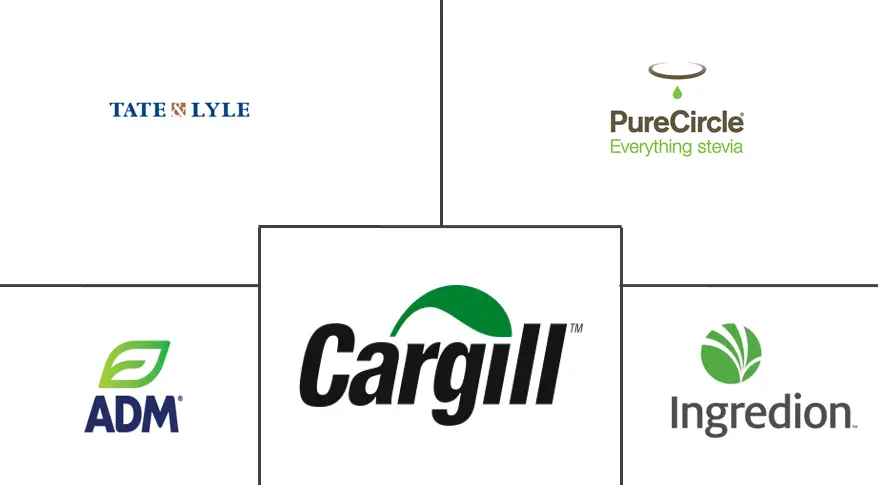Market Size of Middle East & Africa Low Calorie Sweeteners Industry

| Study Period | 2019 - 2029 |
| Base Year For Estimation | 2023 |
| Forecast Data Period | 2024 - 2029 |
| Historical Data Period | 2019 - 2022 |
| CAGR | 5.80 % |
| Market Concentration | Medium |
Major Players
*Disclaimer: Major Players sorted in no particular order |
MEA Low Calorie Sweeteners Market Analysis
The Middle East and Africa Low Calorie Sweeteners Market is expected to grow at a CAGR of 5.8%, during the forecast period, 2020 to 2025.
- An increasing demand for low-calorie sweeteners from food and beverage manufacturers has witnessed a significant growth in the last few years, owing to the rising concern over obesity and diabetes, across the region.
- Furthermore, products such as stevia has a less penetration rate in the Middle East as compared to the developed countries however, such products is expected to witness healthy growth over the coming years. On the other hand, major players operating in the industry are seeking to invest heavily and diversify their existing product portfolio in the region that will enable them to incorporate stevia into traditionally consumed products. In addition to the above mentioned facts, the proposed sugary beverage tax in countries such as that of Saudi Arabia and UAE might act as a propeller for the industry to move forward.
MEA Low Calorie Sweeteners Industry Segmentation
The Middle East and Africa Low Calorie Sweetener Market is segmented by source, product, application and geography. Based on source type, the market is segmented into natural and artificial. Based on product type the market is segmented into sucralose, saccharin, aspartame, neotame, advantame, acesulfame potassium, stevia, and others. Based on application the market is segmented into food further sub segmented into dairy & frozen foods, confectionery, bakery and others, beverage, pharmaceuticals, and others. Based on geography, the study provides an analysis of the low calorie sweetener market in South Africa, Saudi Arabia, United Arab Emirates and Rest of Middle East & Africa.
| By Source Type | |
| Natural | |
| Artificial |
| By Product Type | |
| Sucralose | |
| Saccharin | |
| Aspartame | |
| Neotame | |
| Advantame | |
| Acesulfame Potassium | |
| Stevia | |
| Others |
| By Application | ||||||
| ||||||
| Beverage | ||||||
| Pharmaceuticals | ||||||
| Others |
| By Country | |
| South Africa | |
| Saudi Arabia | |
| United Arab Emirates | |
| Rest of Middle East & Africa |
Middle East & Africa Low Calorie Sweeteners Market Size Summary
The Middle East and Africa low-calorie sweeteners market is experiencing notable growth, driven by increasing demand from food and beverage manufacturers due to rising concerns over obesity and diabetes in the region. The market is characterized by a growing interest in natural alternatives like stevia, which, despite its lower penetration compared to developed countries, is expected to see healthy growth. This growth is further supported by legislative measures such as the proposed sugary beverage tax in countries like Saudi Arabia and the UAE, which are encouraging the adoption of reduced sugar content products. The market is also influenced by government initiatives aimed at combating lifestyle diseases, promoting healthier eating habits among consumers, and supporting the incorporation of sugar substitutes in various food products.
In South Africa, the approval of stevia for use has catalyzed its market growth, with increasing awareness of its health benefits driving consumer demand for healthier alternatives. This has led to significant investments in the local cultivation and processing of stevia, positioning South Africa for potential full-scale commercialization. The market is moderately fragmented, with major international players like PureCircle, Tate & Lyle, ADM, and Cargill holding a strong presence. These companies leverage their broad product ranges and geographical reach to maintain a competitive edge, focusing on innovative product launches and strategic expansion into new markets to meet diverse consumer preferences.
Middle East & Africa Low Calorie Sweeteners Market Size - Table of Contents
-
1. MARKET DYNAMICS
-
1.1 Market Drivers
-
1.2 Market Restraints
-
1.3 Porter's Five Forces Analysis
-
1.3.1 Threat of New Entrants
-
1.3.2 Bargaining Power of Buyers/Consumers
-
1.3.3 Bargaining Power of Suppliers
-
1.3.4 Threat of Substitute Products
-
1.3.5 Intensity of Competitive Rivalry
-
-
-
2. MARKET SEGMENTATION
-
2.1 By Source Type
-
2.1.1 Natural
-
2.1.2 Artificial
-
-
2.2 By Product Type
-
2.2.1 Sucralose
-
2.2.2 Saccharin
-
2.2.3 Aspartame
-
2.2.4 Neotame
-
2.2.5 Advantame
-
2.2.6 Acesulfame Potassium
-
2.2.7 Stevia
-
2.2.8 Others
-
-
2.3 By Application
-
2.3.1 Food
-
2.3.1.1 Dairy and Frozen Foods
-
2.3.1.2 Confectionery
-
2.3.1.3 Bakery
-
2.3.1.4 Others
-
-
2.3.2 Beverage
-
2.3.3 Pharmaceuticals
-
2.3.4 Others
-
-
2.4 By Country
-
2.4.1 South Africa
-
2.4.2 Saudi Arabia
-
2.4.3 United Arab Emirates
-
2.4.4 Rest of Middle East & Africa
-
-
Middle East & Africa Low Calorie Sweeteners Market Size FAQs
What is the current Middle East & Africa Low Calorie Sweeteners Market size?
The Middle East & Africa Low Calorie Sweeteners Market is projected to register a CAGR of 5.80% during the forecast period (2024-2029)
Who are the key players in Middle East & Africa Low Calorie Sweeteners Market?
Tate & Lyle, Cargill incorporated, ADM and Pure Circle are the major companies operating in the Middle East & Africa Low Calorie Sweeteners Market.

